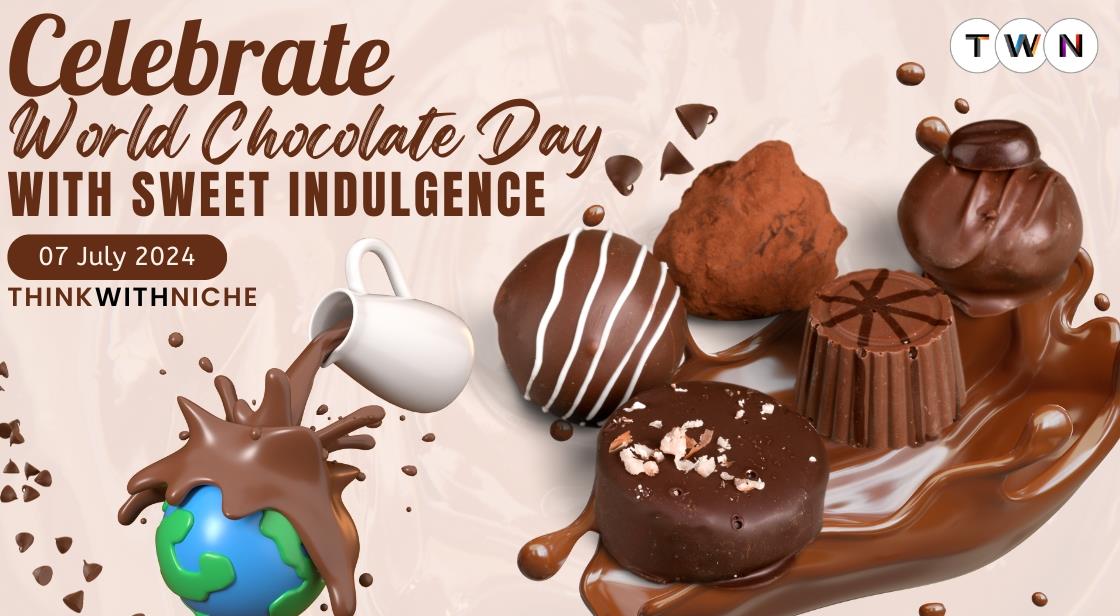Celebrate World Chocolate Day 2024 with Sweet Indulgence

Blog Post
Every year on July 7th, chocolate lovers worldwide come together to celebrate a treat that spans centuries and continents: chocolate. World Chocolate Day isn't just another date on the calendar; it's a global tribute to the rich tapestry of history, cultural diversity, and irresistible charm that chocolate embodies.
From its humble beginnings in ancient Mesoamerica, where the Aztecs and Mayans revered cacao as a divine gift, to its transformation into a universally adored confection, chocolate has woven itself into the fabric of human indulgence and celebration.
The journey of chocolate is a fascinating exploration of cultural significance. In European courts during the Renaissance, chocolate was introduced as a luxurious beverage, heralding its rise from a bitter elixir to a symbol of wealth and sophistication.
Today, chocolate continues to evolve, with Swiss artisans perfecting velvety smooth bars and Belgian chocolatiers crafting exquisite pralines, each contributing uniquely to its enduring allure.
Beyond its cultural heritage, chocolate offers surprising health benefits. Rich in antioxidants like flavonoids, dark chocolate, in particular, promotes heart health by enhancing blood flow and lowering blood pressure.
Its serotonin and endorphin content also uplifts mood and fosters a sense of well-being, making it not just a treat for the palate but a comfort for the soul.
World Chocolate Day 2024 invites everyone, whether aficionados of dark, milk, or white chocolate, to savor the stories and flavors that make this delicacy beloved worldwide.
Join us as we delve into the joyous traditions, from chocolate festivals in Paris to cocoa-rich dishes in Mexico, celebrating the enduring magic of chocolate and its ability to bring delight to every occasion.
Enjoy World Chocolate Day 2024 with Delicious Treats
Introduction to World Chocolate Day
World Chocolate Day is celebrated annually on July 7th, marking a global homage to one of humanity's most beloved treats. This day honors the rich history, cultural significance, and universal appeal of chocolate across the globe.
Significance of Chocolate in Various Cultures
Chocolate holds a profound significance in diverse cultures worldwide. Originating from ancient civilizations like the Aztecs and Mayans in Mesoamerica, chocolate was initially consumed as a bitter beverage reserved for royalty and religious rituals. Over centuries, chocolate has evolved into a cherished confection enjoyed by people of all ages and backgrounds.
In European cultures, chocolate gained popularity during the Renaissance era when it was introduced as a sweetened beverage. It later transformed into solid bars and various decadent treats that became synonymous with indulgence and celebration.
Popularity Worldwide of Chocolate
Today, chocolate remains an integral part of global cuisine and traditions. From Swiss chocolate artisans crafting velvety smooth bars to Belgian chocolatiers perfecting delicate pralines, each region has contributed uniquely to chocolate's enduring appeal. In Latin America, cocoa beans are celebrated as a cultural heritage, with traditional recipes passed down through generations.
Modern-Day Celebration of World Chocolate Day
On World Chocolate Day, enthusiasts around the world indulge in chocolate in all its forms. It's a day marked by chocolate-themed events, tastings, and promotions by chocolatiers and confectioners. Social media platforms buzz with chocolate enthusiasts sharing their favorite treats and recipes, fostering a global community united by their love for chocolate.
History of Chocolate
Origins of Chocolate: Aztecs and Mayans
Chocolate has a rich history that traces its origins back to ancient Mesoamerican civilizations, particularly the Aztecs and Mayans. For these civilizations, chocolate held significant cultural and ceremonial importance beyond its culinary use.
The Aztecs, for instance, believed cacao beans (the primary ingredient of chocolate) were a gift from the god Quetzalcoatl and used them as currency, offering them during rituals and as tributes.
The Bitter Drink of the Gods
Initially, chocolate was consumed as a bitter, frothy beverage. The Aztecs prepared it by fermenting, roasting, and grinding cacao beans into a paste, which was then mixed with water, chili peppers, and other spices like vanilla and honey.
This concoction, known as "xocolātl," was reserved for the elite and served during religious ceremonies and feasts. It was valued not only for its taste but also for its perceived medicinal and spiritual properties.
Evolution to a Sweet Confection
The transformation of chocolate from a bitter beverage to the sweet confection we know today began with the arrival of Europeans in the Americas. During the 16th century, Spanish explorers like Hernán Cortés encountered chocolate and brought it back to Europe. Initially, it remained a luxury item enjoyed by royalty and nobility, who added sugar and spices to make it more palatable.
Industrial Revolution and Mass Production
The 19th century marked a significant shift in chocolate production with the Industrial Revolution. Innovations such as steam-powered mills and hydraulic presses enabled mass production and the refinement of chocolate-making techniques. This led to the creation of solid chocolate bars, candies, and other confections that became accessible to a wider audience.
Modern Chocolate Industry
In the 20th and 21st centuries, the chocolate industry continued to evolve with advancements in technology and global trade. Chocolate became a ubiquitous treat enjoyed worldwide, with multinational corporations and artisanal chocolatiers alike innovating new flavors, textures, and products. Today, chocolate is not only a beloved indulgence but also a versatile ingredient used in desserts, beverages, and culinary creations across cultures.
Also Read: Discover the World's Most Romantic Honeymoon Destinations
Health Benefits of Chocolate
Chocolate, often associated with indulgence, also boasts several surprising health benefits that make it more than just a treat.
Antioxidant Properties
One of the standout features of chocolate is its high antioxidant content, primarily due to the presence of flavonoids. Flavonoids are potent antioxidants that help neutralize free radicals in the body, reducing oxidative stress and inflammation. Dark chocolate, in particular, contains higher levels of flavonoids compared to milk or white chocolate, making it a healthier choice.
Potential Heart Health Benefits
Moderate consumption of chocolate has been linked to potential heart health benefits. Studies suggest that the flavonoids in dark chocolate may contribute to improved blood flow, reduced blood pressure, and a lower risk of heart disease. These effects are attributed to the ability of flavonoids to stimulate the production of nitric oxide, which relaxes and dilates blood vessels, improving circulation.
Mood-Enhancing Effects
Chocolate is renowned for its mood-enhancing properties, thanks to its content of serotonin and endorphins. Serotonin, a neurotransmitter known as the "feel-good" chemical, contributes to feelings of happiness and well-being. Endorphins, another group of neurotransmitters, act as natural painkillers and mood lifters. Consuming chocolate can stimulate the release of these chemicals in the brain, promoting feelings of relaxation and pleasure.
Cognitive Benefits
Research suggests that the flavonoids in chocolate may also benefit cognitive function. Regular consumption of cocoa and dark chocolate has been associated with improved memory, focus, and overall brain health. These cognitive benefits are attributed to the antioxidant and anti-inflammatory properties of flavonoids, which help protect brain cells from damage and support healthy aging.
Considerations for Consumption
While chocolate offers potential health benefits, it's essential to consume it in moderation. Excessive consumption can lead to weight gain and other health issues due to its high sugar and calorie content, especially in milk and white chocolate varieties. Opting for dark chocolate with a higher cocoa content (70% or more) maximizes health benefits while minimizing sugar intake.
Types of Chocolate
Chocolate comes in various types, each distinguished by its ingredients, cocoa content, and flavor profiles, catering to different tastes and preferences.
Dark Chocolate
Dark chocolate is known for its rich, intense flavor derived from a higher cocoa content and minimal added sugar. Typically, it contains at least 70% cocoa solids, imparting a bittersweet taste with hints of fruitiness or earthiness depending on the origin of the cocoa beans. Dark chocolate is favored by those who enjoy deep chocolate flavors and benefits from antioxidants present in cocoa.
Milk Chocolate
Milk chocolate is sweeter and creamier than dark chocolate, thanks to the addition of milk solids or milk powder along with cocoa solids and sugar. It generally has a lower cocoa content, typically ranging from 30% to 50%. Milk chocolate offers a smoother texture and a milder chocolate taste, making it popular among individuals who prefer a sweeter chocolate experience.
White Chocolate
White chocolate stands out for its ivory color and creamy texture, but it differs significantly in composition from dark and milk chocolates. It contains cocoa butter, milk solids, and sugar but lacks cocoa solids. This gives it a mild, sweet flavor with notes of vanilla from the added ingredients. White chocolate is prized for its smoothness and versatility in confections and desserts.
Specialty Chocolates: Truffles and Pralines
Specialty chocolates like truffles and pralines are artisan-crafted confections that often feature a combination of different chocolate types or unique fillings. Truffles are typically made with a ganache center coated in chocolate and dusted with cocoa powder or nuts, offering a luxurious, velvety texture and intense chocolate flavor. Pralines, on the other hand, are chocolate-coated confections filled with nuts, nougat, or fruit preserves, providing a delightful blend of textures and flavors.
Cocoa Content and Flavor Profiles
The cocoa content in chocolate significantly influences its taste and texture. Higher cocoa content generally results in a more intense chocolate flavor with less sweetness. Dark chocolates with 70% or higher cocoa content are considered to have complex flavor profiles, ranging from fruity and floral to earthy and nutty, depending on the origin of the cocoa beans. In contrast, lower cocoa content in milk chocolate contributes to its sweeter taste, complemented by the creaminess from added milk solids.
Understanding the different types of chocolate and their varying cocoa content allows chocolate enthusiasts to appreciate the diversity of flavors and textures available, catering to a wide range of preferences from intense dark chocolates to smooth and sweet milk chocolates, and indulging in the luxury of specialty chocolates like truffles and pralines.
How to Celebrate World Chocolate Day 2024
Celebrating World Chocolate Day 2024 with these activities ensures a fun-filled day of chocolate exploration, whether you're tasting, learning, or creating chocolate delights. Each activity offers a unique way to immerse yourself in the world of chocolate, appreciating its flavors, craftsmanship, and joyous moments shared with others.
Host a Chocolate Tasting Party with Friends and Family
One delightful way to celebrate World Chocolate Day 2024 is by hosting a chocolate tasting party. Gather your friends and family to indulge in a variety of chocolate treats. You can create a tasting menu featuring different types of chocolate: dark, milk, white, and perhaps some specialty chocolates like truffles or pralines. Provide tasting notes and encourage everyone to share their favorites. This interactive and social event allows participants to appreciate the nuances of chocolate flavors and textures while enjoying each other's company.
Visit a Local Chocolate Factory or Artisan Chocolatier for a Tour
Another fantastic way to celebrate is by visiting a local chocolate factory or artisan chocolatier for a guided tour. Many chocolate makers offer behind-the-scenes tours where you can witness the chocolate-making process from bean to bar. Learn about the origins of cocoa beans, the art of chocolate tempering, and the craftsmanship involved in creating exquisite chocolates. Some tours may even include tastings or workshops where you can try your hand at chocolate-making techniques under expert guidance. It's a memorable experience that deepens your appreciation for chocolate and supports local artisans.
Try Baking Chocolate Desserts at Home
For those who enjoy baking, World Chocolate Day is the perfect occasion to whip up some decadent chocolate desserts at home. From classic favorites like chocolate brownies and chocolate chip cookies to more elaborate treats such as chocolate cakes or molten lava cakes, there's a chocolate dessert for every skill level. Experiment with different recipes, ingredients, and decorating techniques to create personalized treats that delight your taste buds. Baking chocolate desserts at home not only fills your kitchen with delicious aromas but also allows you to share homemade goodies with loved ones, spreading the joy of chocolate on this special day.
Global Chocolate Traditions
Chocolate is cherished worldwide, and each culture has its own unique way of celebrating and incorporating this beloved treat into its culinary traditions. From festivals to traditional dishes, here’s a glimpse into some of the most fascinating chocolate traditions around the globe.
Chocolate Festivals and Events
Chocolate festivals are a sweet way for countries to celebrate their love for chocolate. The Salon du Chocolat in Paris, one of the most famous chocolate events globally, showcases the finest chocolates and confections from around the world. This festival features workshops, tastings, and demonstrations by renowned chocolatiers, making it a paradise for chocolate lovers.
In Belgium, the Brussels Chocolate Festival is a must-visit, where chocolate enthusiasts can indulge in tastings, chocolate-making workshops, and meet the finest chocolatiers. Similarly, the Chocolate Festival in Cologne, Germany, celebrates chocolate with tastings, chocolate sculptures, and a variety of chocolate-themed activities, attracting visitors from across the globe.
Unique Chocolate-Based Dishes and Beverages
Different cultures have their own traditional chocolate-based dishes and beverages that highlight the versatility of chocolate. In Mexico, mole poblano is a rich sauce made with chocolate, chili peppers, and spices, often served with chicken. This dish exemplifies how chocolate can add depth and complexity to savory dishes.
In Spain, churros with chocolate is a popular treat, where crispy fried dough is dipped into thick, rich hot chocolate, creating a perfect combination of textures and flavors. Hot chocolate is also a significant part of Italian culture, particularly in Turin, where the thick, velvety hot chocolate is enjoyed at historic cafes.
Beyond the Sweet
In some cultures, chocolate is not just a dessert but a part of everyday cuisine. In Switzerland, chocolate fondue is a beloved dish, where pieces of fruit, bread, and marshmallows are dipped into melted chocolate, making for a delightful communal dining experience. Meanwhile, in Ecuador, chocolate drinks are often spiced with cinnamon, cloves, and sometimes chili, creating a rich and aromatic beverage that highlights the country’s rich cocoa heritage.
Sustainable and Ethical Chocolate Practices
Sustainable Chocolate Production
Sustainable chocolate production emphasizes practices that minimize environmental impact, conserve biodiversity, and promote the well-being of cocoa farmers and local communities. Key aspects include:
Environmental Conservation
Sustainable chocolate production focuses on reducing deforestation and preserving natural habitats. This involves implementing agroforestry techniques where cocoa trees are grown alongside other native plants, promoting biodiversity. Additionally, sustainable practices prioritize the responsible use of water and energy resources to minimize ecological footprint.
Fair Trade Practices
Fair trade initiatives ensure that cocoa farmers receive fair prices for their crops, providing them with stable incomes and improving their living standards. Fair trade certification programs also emphasize safe working conditions, prohibiting child labor, and promoting gender equality within cocoa farming communities.
Promoting Ethical Sourcing of Cocoa Beans
Ethical sourcing of cocoa beans involves transparent supply chains and partnerships with farmers that prioritize their socio-economic well-being. Key initiatives include:
Direct Trade Relationships
Some chocolate brands establish direct trade relationships with cocoa farmers, bypassing intermediaries to ensure farmers receive higher prices for their crops. This approach fosters trust, promotes farmer empowerment, and enables investments in community development projects.
Certification Programs
Certification programs such as Fair Trade USA, Rainforest Alliance, and UTZ Certified validate ethical sourcing practices. These certifications verify that cocoa beans are produced under strict social, environmental, and economic standards, benefiting both farmers and consumers who prioritize ethical consumption.
Top Leading Chocolate Brands Worldwide
Several brands and initiatives are championing sustainable and ethical chocolate practices:
Cadbury
Founded in 1824 by John Cadbury in the UK, Cadbury, formerly known as Cadbury’s, has become a beloved global chocolate brand. In 2010, ownership transferred to the British multinational Mondelez International, a prominent confectionery company. Cadbury first began importing chocolates to India in 1948 and later established itself there. The Cadbury Dairy Milk collection, in particular, has garnered a massive fan base in India, often being passed down through generations as birthday gifts or rewards.
Hershey’s
Established in 1894 by Milton Snavely Hershey, Hershey’s is one of the largest chocolate manufacturers in the world. The first Hershey bar was sold in 1900, marking the beginning of the brand's global success. Hershey's chocolates gained such popularity that they were even supplied to the US armed forces during World War II. Among its extensive product lineup, Hershey’s KISSES stands out as the most beloved and popular, known for its distinctive shape and creamy taste.
Ferrero Rocher
Founded by Michele Ferrero in 1982 in Italy, Ferrero Rocher is synonymous with luxury chocolates. These hazelnut-centered milk chocolate balls are a creamy and crunchy delight, meticulously wrapped in gold foil. Ferrero Rocher is often gifted worldwide and is considered a premium offering, with a price point higher than many other chocolate brands in the market.
Nestle
Henri Nestle founded the Swiss multinational Nestle in 1866. While Nestle is known for a wide array of products, including pet care and baby food, it has also made a significant mark in the chocolate industry. Nestle’s Kit Kat is the most popular chocolate wafer in the world, with its famous tagline “Take a Kit-Kat Break” recognized globally. Kit Kat comes in various sizes, from bite-sized wafers to large slabs, making it a versatile and widely enjoyed treat.
Lindt & Sprüngli
Lindt & Sprüngli has implemented sustainable sourcing programs focusing on responsible cocoa farming practices and environmental conservation. They partner with farmers to improve agricultural techniques, enhance productivity, and ensure long-term sustainability of cocoa production.
Indulgent Chocolate Recipes
Indulging in chocolate is a perfect way to celebrate World Chocolate Day 2024. Here are some delectable recipes that cater to various dietary preferences, ensuring everyone can enjoy the sweet indulgence.
Classic Chocolate Truffles
Ingredients:
-
200g dark chocolate, finely chopped
-
1/2 cup heavy cream (use coconut cream for vegan option)
-
2 tbsp unsalted butter (use vegan butter for vegan option)
-
Cocoa powder, powdered sugar, or chopped nuts for coating
Instructions:
-
Heat the cream in a saucepan until just simmering.
-
Pour hot cream over the chopped chocolate in a bowl. Let it sit for 1-2 minutes, then stir until smooth.
-
Stir in the butter until fully incorporated and smooth.
-
Chill the mixture in the refrigerator for 1-2 hours until firm.
-
Scoop out small portions and roll them into balls.
-
Roll the truffles in cocoa powder, powdered sugar, or chopped nuts for coating.
-
Chill again until ready to serve. Enjoy these rich, melt-in-your-mouth truffles!
Decadent Chocolate Fondue
Ingredients:
-
200g dark chocolate, chopped
-
1/2 cup heavy cream (use coconut cream for vegan option)
-
Assorted fruits (strawberries, bananas, pineapple), marshmallows, and pretzels for dipping
Instructions:
-
Heat the cream in a saucepan until just simmering.
-
Pour the hot cream over the chopped chocolate in a fondue pot or heatproof bowl.
-
Stir until the chocolate is melted and smooth.
-
Place the fondue pot over a low flame or use a fondue set to keep warm.
-
Arrange assorted fruits, marshmallows, and pretzels on a platter for dipping.
-
Enjoy dipping and swirling these delicious treats in warm, velvety chocolate fondue!
Vegan and Gluten-Free Chocolate Avocado Mousse
Ingredients:
-
2 ripe avocados, peeled and pitted
-
1/2 cup cocoa powder
-
1/2 cup maple syrup or agave syrup
-
1 tsp vanilla extract
-
Pinch of salt
-
Optional toppings: whipped coconut cream, berries, or shaved chocolate
Instructions:
-
In a food processor, combine avocados, cocoa powder, maple syrup, vanilla extract, and salt.
-
Blend until smooth and creamy, scraping down the sides as needed.
-
Taste and adjust sweetness as desired.
-
Spoon the mousse into serving dishes or glasses.
-
Chill in the refrigerator for at least 30 minutes to set.
-
Serve topped with whipped coconut cream, berries, or shaved chocolate for an indulgent, guilt-free dessert.
Conclusion
Today, as we celebrate World Chocolate Day, we not only savor the exquisite flavors and textures of chocolate but also appreciate its profound cultural significance. Whether enjoyed in the form of velvety Swiss bars, delicate Belgian pralines, or traditional Mexican mole poblano, chocolate connects us through shared traditions and culinary pleasures.
You May Like
EDITOR’S CHOICE












